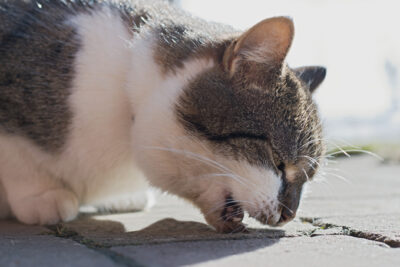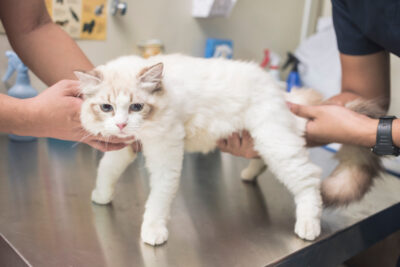15 Cat Liver Failure Symptoms You Shouldn’t Ignore

The liver is an incredible organ in cats. Located just below the diaphragm, which separates the chest from the abdomen, the liver has multiple lobes and is the largest internal organ in a cat’s body. It performs numerous functions to keep our feline friends healthy, including metabolizing drugs, converting glucose to energy, and removing waste products. It’s even capable of regenerating itself!
However, cats can quickly become seriously ill and will need immediate veterinary care when their liver fails. That’s why it’s important to recognize the symptoms of cat liver failure. This will help you know what to do if your cat’s liver stops working.
Liver Failure Vs. Liver Disease in Cats
First, let’s explain the difference between liver failure and liver disease.
Liver Disease
Liver disease in cats occurs when an insult to the liver, such as an infection, reduces its ability to function. Cats with liver disease can still function reasonably well because the liver can regenerate itself and continue carrying out most of its functions even when diseased.
Liver Failure
Liver failure occurs when at least 70 percent of the liver’s function is lost, indicating that the liver can withstand quite a bit of injury before liver failure sets in. This massive loss of function can happen suddenly, and a cat will look visibly ill when their liver starts failing.
Without prompt and aggressive treatment, a cat with liver failure is unlikely to survive.
15 Cat Liver Failure Symptoms

The liver performs many essential functions that affect the entire body. Therefore, liver failure symptoms in cats occur throughout the body.
Since it’s easiest to think of liver failure symptoms according to the body system, that’s how we’ve broken them down.
Gastrointestinal Symptoms
The liver performs many digestive functions like converting glucose to energy, producing and releasing bile to help digest food, and storing fat-soluble vitamins (A, D, E, K). With liver failure, a cat will experience various digestive issues:
- Vomiting
- Diarrhea
- Bloody poop
- Decreased or complete loss of appetite
Nervous System Symptoms
When the liver fails, a brain condition called hepatic encephalopathy develops because the liver can no longer rid the body of ammonia. This brain disease causes brain tissue to break down, leading to numerous nervous system symptoms:
- Tremors
- Staggering
- Depression
- Altered mental status
- Head pressing against a wall
Urinary Tract (Kidney) Symptoms
The liver plays a significant role in filtering out toxins. When failing, the liver cannot carry out this role. Toxins accumulate in the blood, resulting in more work for the kidneys to filter these toxins and rid the body of them through urine. This extra work eventually damages the kidneys, causing the symptoms listed below:
- Lethargy
- Weight loss
- Increased urination
Hepatobiliary
“Hepatobiliary” is a fancy term for the combination of the liver and gallbladder. When the liver fails, certain symptoms indicate a loss of function of the of these two organs:
- Ascites (fluid buildup in the abdomen)
- Jaundice (yellowing of the skin, eyes, and mucus membranes; one of the telltale signs of liver disease and liver failure)
Immune/Lymphatic/Hemic Symptoms
The liver plays an essential role in immune health and clotting ability. Liver failure causes delayed clotting.
What to Do If You Notice Symptoms of Liver Failure in Cats
If you notice any of the symptoms listed above, especially if they appeared suddenly, take your cat to your veterinarian as soon as possible.
It’s also important to understand that some of the symptoms, like vomiting and appetite loss, are not specific to liver failure. Your veterinarian will perform various diagnostic tests to definitively diagnose liver failure in your cat. Just be aware that diagnosing liver failure can be extensive and expensive.
First, your veterinarian will perform a complete physical exam and ask you for a detailed history of the problem. They will ask you questions like these:
- What is your cat’s current diet?
- Has your cat recently ingested any poisons?
- What medications does your cat currently take?
- What symptoms have you noticed, and when did they start?
Your veterinarian will assess your cat’s body systems during the physical exam. As previously mentioned, the presence of jaundice in cats is a clear sign that something is wrong with the liver.
Your veterinarian will then perform various diagnostic tests to diagnose liver failure, including:
- Urinalysis
- Abdominal X-rays
- Abdominal ultrasound
- Basic bloodwork: complete blood count, biochemical profile
- Specialized bloodwork, including clotting tests and bile acid measurements
- Exploratory surgery to visualize the liver and take a biopsy
Treatment for Cats with Liver Failure

Quick intervention is necessary for cats with liver failure to give them the best chance of survival and recovery. Your veterinarian will use the results of the physical exam and diagnostic tests to develop the best treatment plan for your cat.
Treatment is dependent on the underlying cause and is geared toward relieving symptoms:
- Antibiotic therapy
- Oxygen supplementation
- Intravenous fluid therapy
- Anti-nausea medications
- Medications to regulate blood clotting
- Hepatoprotectants to protect the liver
- Nutritional support with a feeding tube
- Diuretics to flush out excess fluid and prevent brain swelling
Cats with liver failure must be hospitalized for treatment and are monitored frequently. Restricted activity is necessary for the liver to regenerate and regain function.
Prognosis for Cats with Liver Failure
Without treatment, the majority of cats with liver failure will not survive. However, receiving treatment does not guarantee survival. The prognosis for a cat with liver failure also depends on the underlying cause and how much of the liver has been damaged before treatment begins.
Cats that survive the first few days of treatment typically have a good chance of recovery, with full recovery taking approximately three to six weeks. Early treatment and intervention greatly improve the chances of recovery.









